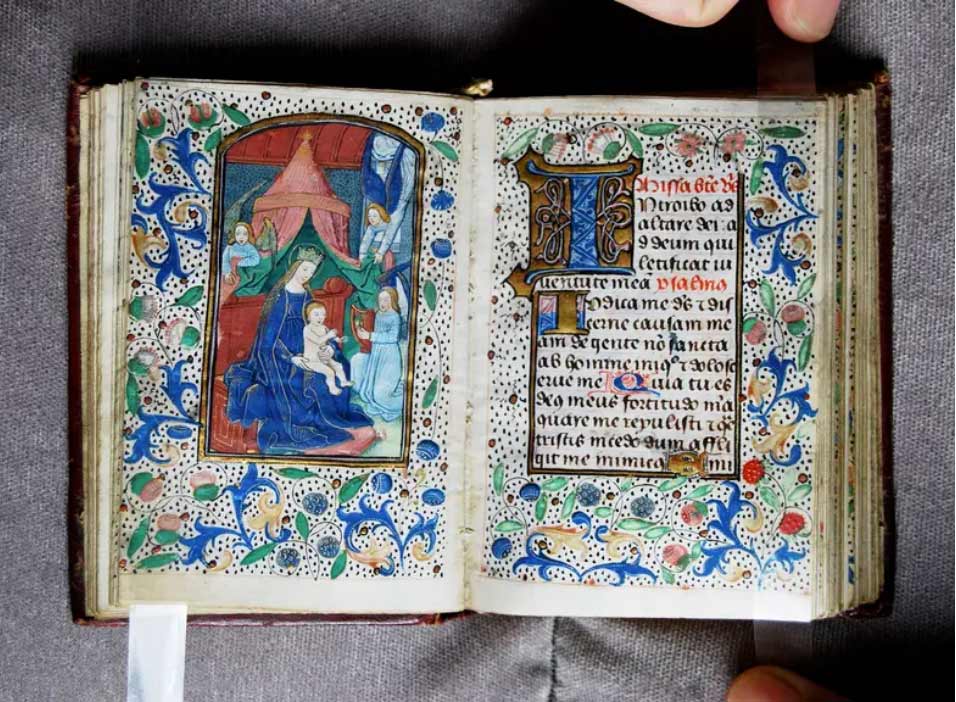An unpublished manuscript illuminated in Portugal for King João II
Ípsilon, the cultural supplement of Público newspaper, dedicated an article to the Book of Hours of King João II. The research, led by a team from IEM, has been studying the book, discovered about a year ago in a private collection.
By Delmira Espada Custódio and Maria Adelaide Miranda, IEM|FCSH-NOVA researchers
Very recently, a private collection was found to contain an unpublished manuscript and illuminated Book of Hours, of great interest to the history of Portuguese art and culture and, in particular, to the history of illumination and navigation during the reign of King João II. We were immediately struck by its calendar, which differs sharply from those usually found in this type of work. Our interest grew as our eyes travelled over the codex because, right after the calendar, we encountered several folios written in Portuguese, which is a bibliographic rarity of unquestionable historical and artistic value.
It was, however, the reading of this same text that highlighted the real importance of the codex in our hands, revealing, in two brief lines, that it was commissioned by a Castilian prelate in the service of the Portuguese court, as the text clearly states: “Composto pelo lece[n]ciado calcadilha per mandado del rei ao meridiano and ladeza de lixboa o ano de 1483“. We thus learn that the book was commissioned by King João II (1455-1495) from one of the most important astronomers at the Portuguese court, the Castilian Diogo Ortiz de Villegas († 1519), often referred to as Calçadilha. This respected theologian arrived in Portugal in 1475, still during the reign of Afonso V, as confessor to her excellency Princess Joana, following the conflict of Toro that opposed Afonso V against the Catholic Kings Fernando and Isabel, and he would become a leading figure during the reigns of Afonso’s successors, João II and Manuel I.
It is a small codex (115 x 80 mm), made of vellum with different thicknesses, with 206 enumerated folios, grouped into eighteen notebooks of various and irregular composition. It is quite complete and well preserved, preserving twenty-two full-page illuminations out of the twenty-three that the codex originally contained. The text, in Latin and Portuguese, set in a single column of 15 lines, is written in black, with red initials, and suggests it was mostly executed by a single scribe, although there were clearly two illuminators. The margins, illuminated with stylised blue and yellow acanthus, and floral elements depicted with some realism – blackberries, strawberries, daisies, dandelions, among others more difficult to identify -, are complete, involving the iconographic themes and the text columns in the adjacent folio. The main parts of the texts – called sections – are marked by full-page illuminations, organised into double folios, and with hierarchical subdivisions, with ornate initials at 2, 4, 5 and 6 spaces, filigree initials with one space, calligraphic initials (rarer), lines and, very occasionally, cauldrons. An artistic/iconographic study of the themes related to what remains of the painting and illumination from this period in Portugal may become a key factor for characterising the arts of colour, both nationally and in an international context.
The ownership marks preserved in the codex indicate two other owners, in particular: José Jacinto Tavares († 9 June 1863), Prior in the Church of Santa Isabel, commendatory and deputy of the Portuguese nation, and the Italian abbot, Caetano Cav. Frascarelli († after 1868), Knight of the Royal Military Order of Christ in Portugal,a member of the Apostolic Nunciature during the reign of Queen Maria II, and author of several works, among which stand out, due to their relationship to Portugal, Inscriptiones regum Lusitanorum, published in 1850, and Iscrizioni portoghesi che esistono in diversi luoghi di Roma, in 1868.
The detailed study of this remarkable example of the humanist spirit of the João era court, which we intend to publish very soon and of which we provide here but a small sketch, counts on the participation of a large team of researchers – Aires Augusto Nascimento (CEC|FLUL), Carlos Manuel Pereira Fontes, Delmira Espada Custódio (IEM|FCSH-UNL), Henrique Leitão (CIUHCT|UL), Horácio Augusto Peixeiro (APH), José Madruga Carvalho (CIUHCT|UL), Josefina Planas Badenas (Universitat de Lleida) and Maria Adelaide Miranda (IEM|FCSH-UNL) -, who, like us, were similarly infected by the joy that the scientific interest of such an important and unexpected discovery may bring.
The article in the Ípsilon supplement of the Público newspaper is available here and here.
